Every Thanksgiving I pretend that this is a holy day when we reaffirm that this land is sacred. I have always loved Thanksgiving for two reasons: The excuse it gives to gather with family and friends. And because it is our only holiday that features native plants, like cranberries, and animals, like turkeys. This feast feeds my body and my soul, because it gives us the opportunity to celebrate the wild beings of this land.
Thanksgiving is not a happy, festive event for everyone. Sadly, many of us don’t have family to celebrate with. Sadly, this year Covid (which has exposed our very poor treatment of wild animals) will prevent the usual gatherings. Sadly, Thanksgiving has never been a happy occasion for Native Americans. They have much to teach us about gratitude, the giving of thanks.
Last November we attended the annual North Carolina Native American Heritage Festival in Raleigh, our capital. North Carolina has the largest population of Native Americans east of the Mississippi. At this year’s online festival, our eight state-recognized tribes shared contemporary arts, historical crafts, storytelling, regalia making, language classes, indigenous foods, drumming and dancing. These are the descendants of the ancestors of this beautiful place that I call home. Can I let this land speak through them?
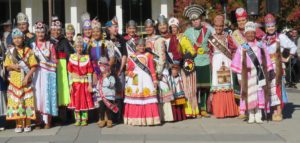
This experience instilled in me a desire to learn more about how our Native people see Thanksgiving. The tribes have made great contributions to the education system’s efforts to revise the teaching of the Thanksgiving story to include the indigenous point of view. The National Museum of the American Indian has published articles about Thanksgiving, and countless Native writers have written stories that illustrate the Indian perspective.
I’ve learned that there are two very different stories about the “original” Thanksgiving event. The Euro-American folktale has been romantically embellished, raised almost to the level of an origins myth. The Native story is that what transpired was simply an expression of compassion for the new settlers by the people who lived around what we now call Cape Cod. It was an act of generosity, albeit an act of self-preservation as well, that led to the colonists’ survival.
The Colonists
One hundred and two people sailed on the Mayflower from England. They arrived near what they named Plymouth in December of 1620, very poorly prepared to endure the winter. They didn’t bring much food. They came upon a huge buried cache of seed corn and stole it, but it was too late to plant anything. They didn’t know the new land well enough to hunt or gather much. Only half of them survived, on the stolen corn.
A myth we have inherited is that these settlers were “Pilgrims.” They didn’t call themselves pilgrims. Pilgrims are people who travel to holy places to worship. Oh, that they really had been pilgrims coming to experience the sacredness of this holy land!
No, about forty of these migrants were “Separatists,” religious dissidents who sought freedom from the Church of England in order to create their own “Holy Kingdom.” They saw the residents as heathens with no right to freedom for their own forms of worship. They believed that land that was still wild, not yet “improved,” was theirs to take, the inhabitants having no right to unimproved land. Forests had to be cut and turned into farms in order to be rightfully owned. (The settlers turned this belief into action as they moved westward, whether the particular land was suitable for farming or not. Indians still have no right to own their land, neither the “ceded territories” from which they were forced to move or the reservations to which they were sent.)
When spring came a Wampanoag man named Tisquantum, whom they called “Squanto,” began to teach them how to plant and nurture the indigenous crops, how to hunt the native animals, how and where to catch each species of fish. Basically, he shared with them the native knowledge, gleaned over a thousand years, of how to utilize the amazing abundance of that particular coastal landscape.
Charles Mann says, “More than likely Tisquantum was not the name he was given at birth. In that part of the Northeast, tisquantum referred to rage, especially the rage of manitou, the world-suffusing spiritual power at the heart of coastal Indians’ religious beliefs. When Tisquantum approached the Pilgrims and identified himself by that sobriquet, it was as if he had stuck out his hand and said, Hello, I’m the Wrath of God.”1
The Native Americans
The whole area from Narragansett Bay to Nantucket was the home of the Wampanoag confederation. In their Algonquian language, Massachusett, their name for their coastal lands was Dawnland, ‘the place where the sun rises.’ They were the People of the First Light. 2 They had occupied their land ever since the retreat of the ice first made it inhabitable. Theirs was a sophisticated culture, with well-developed systems of belief and of government. They lived in sixty-nine villages, each with a sachem, a leader who collected a portion of their peoples’ hunt and harvest to distribute to the needy.
The four years before the arrival of the Mayflower had been devastating for the Wampanoag. They, along with almost all of the other Indians of “New England,” especially those who lived along the coast, had been decimated by the diseases that the European explorers had introduced. Historians estimate that up to three-fourths of the Wampanoags had died; whole villages had been wiped out.
Theirs was a very diverse landscape. In spring and summer the Wampanoag fished the coast and cultivated several varieties of corn, beans, and squash. In fall they hunted in the surrounding forests, woodlands kept open by annual burning, and gathered wild nuts and berries. They dried what they could of these and stored them in underground caches. Some they traded with neighbors for goods they themselves did not produce.
They knew their lands and waters intimately and made offerings of gratitude, such as beads crafted of purple and white shells, to express thankfulness to the earth and the sky beings. In the fall it was their custom to give thanks to Manitou for a bountiful harvest with a ceremony of feasting, dancing, and ritual games that included a “give away” in which families passed possessions on to community members who were in need.
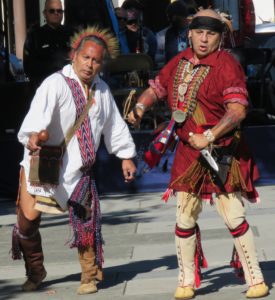
From Harvest Ceremony to Thanksgiving Myth
The seeds that the colonists brought with them had not done well, but the seeds that the Natives had given them produced a good crop of corn. By fall, they wanted to celebrate their successful harvest with an old English custom called Harvest Home. It was not the solemn religious ceremony that so many American paintings portray. In accounts of the event, giving thanks was not even mentioned. Instead it was a secular festival to celebrate harvest with feasting and revelry —dancing and the shooting off of their muskets at targets. They also went “fowling” and brought back a large number of ducks and geese.
Rather than being invited to the feast, as our myth tells it, it seems that when the Wampanoag heard all the firing of muskets, they came to check out the commotion. Upon seeing that the new people were just partying, they joined in the festivities. This three day gathering probably consisted of meetings to secure military cooperation. We’ll protect you from us if you protect us from our enemies. In fact, to gain such protection was the only reason these white people were the first to be allowed to stay on the land for more than a short visit.
Although the tale we have been told is that the English provided the food for the celebration, the Indians hunted and brought back five deer (and also turkeys, their descendants say), so the Wampanoag provided most of the food for this feasting.
We think of this event as happening in late November. Actually, this celebration was probably held in early October when the last of the corn had been harvested. That would also have been when ducks and geese were up, flying in migration, which was why in their “fowling” they would have been able to kill so many wildfowl in one day, as reported.
It was in 1863 that Abraham Lincoln proclaimed a national holiday called Thanksgiving to be held on the fourth Sunday in November. “The country was being torn apart by the Civil War, a war in which brother fought against brother. Lincoln wanted to unify people in the midst of turmoil.” 3 Lincoln proclaimed, “It has seemed to me fit and proper that [the gracious gifts of the Most High God] should be solemnly, reverently and gratefully acknowledged as with one heart and one voice by the whole American People. . . .and fervently implore the interposition of the Almighty Hand to heal the wounds of the nation and to restore it as soon as may be consistent with the Divine purposes to the full enjoyment of peace, harmony, tranquility and Union.”4 Oh, that Lincoln’s “whole American People” had included the American Indians. Oh, that our new president-elect would proclaim Thanksgiving this year as a time to heal our divided country!

As for the other food at the feast, besides wild fowl and venison roasted on spits, perhaps there was a stew of these meats flavored with native garlic and onions. Fish and shellfish would not have been on the menu, because it was too cold to fish by then, and oysters did not grow in this area of the coast. But eels and mussels might have been. Fresh fruits and berries would have been out of season, but nuts and dried fruits might have been served. Maybe the Natives cooked up a succotash made of the three sisters — corn, beans and squash.
No potatoes, either regular or sweet, had arrived up north yet from the southwest, nor had sweet corn for eating off the cob. Their corn dishes probably consisted of nasaump, dried corn pounded and boiled, making a thick porridge. Their pumpkin dish was pompion, cooked and mashed pumpkin, not pie. Cranberries were not utilized because there was no sugar. There is conflicting opinion about the presence of alcohol. Some say the barley crop that year had been too small, while others say there was lots of ale, and even English children were allowed to drink beer.
Another myth is that this was a happy time, the start of a great friendship between the settlers and the Indians. Well, for a generation or two there was peaceful co-existence. For the Wampanoag and surrounding peoples the colonists’ theft of their lands became so intolerable that they had to go to war. More disease decimated the Native peoples. Then followed 500 years of colonization, consisting of the stealing of their land and the cruel and methodical genocide of Native peoples, their languages, their religions, their cultures.
Do we perpetuate the story that our nation was begun on a foundation of cooperation in order to assuage our guilt at what we are doing to our own and other indigenous peoples? Have we taken responsibility for our continuing colonization? It is abundantly clear that we have not yet done so. Our democracy is barely hanging by a thread. African Americans and Native Americans are shouting that equality is truly a myth that we are still trying to perpetuate, so that colonialist supremacy will remain intact.
In 1970 Native Americans declared Thanksgiving a National Day of Mourning and chose Plymouth as the place to observe it. “To them, Thanksgiving has come to symbolize not a beginning but an end: the tragic destruction of their culture,”5 a bitter reminder of 500 years of betrayal returned for friendship. 6

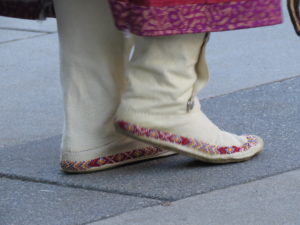
Native American Ways of Giving Thanks
Perhaps the greatest Thanksgiving myth is that the 1641 feast at Plymouth was the “First Thanksgiving.” The Wampanoag Indians were people who gave thanks as part of their daily lives. The first thanksgiving was celebrated tens of thousands of years ago on this continent. And, everywhere else, since we first became humans.
“The ability to live in harmony with the natural world begins with knowing how nature functions. After many generations of observation and experience, Native peoples were intimately familiar with weather patterns, animal behaviors, and cycles of plant life, water supply, and the seasons. They studied the stars, named the constellations, and knew when solstices and equinoxes occurred. This kind of knowledge enabled Native peoples to flourish and to hunt, gather, or cultivate the foods they needed, even in the harshest environments.”7
They had an intimacy with their land that white folks back then found, and we now continue to find, hard to imagine. When the Native peoples were forced off their beloved lands, they describe losing their souls. Their souls and the souls of all the plants and animals of their particular homelands were so intertwined.
According to many Native peoples, their community consists of more than just humans. The animals and plants are treated not only as gifts to be utilized, but also as kin, to be cared for as family members. Humans are members of their totem animals’ clans. These animal relatives, wild foods, medicine plants, and beloved heirloom crops are honored and thanked through ceremonies, stories, songs, dances and art. “These foods and the plants that surround us go way beyond just simply being plants. They become part of the community.” —Angelo Joaquin, Jr. (Tohono O’odham), 2003
Many Native Americans believe, in ways that are as different as their cultures, that if humans respectfully take care of the natural world, nature will, in turn, provide for us. Plant and animal people and human people, all know their own roles and responsibilities in an interconnected web of relationships. Even back when Europeans were indigenous peoples in their own lands they knew that regular expressions of gratitude and many other practices that show respect for the natural world are what maintain a reciprocal relationship with the spirit-filled earth.
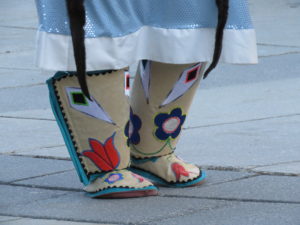
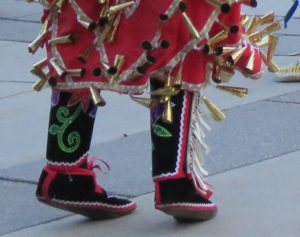
The Haudenosaunee or Iroquois Nation, offers a Thanksgiving Address. Sometimes called “the words that come before all else,” it is recited before meetings, at the beginning of ceremonies, and, in some places, even by children before their school day begins. The people start by giving thanks to fellow humans. Then they give thanks to the Earth: “We are thankful to our Mother the Earth, for she gives us everything we need for life. She supports our feet as we walk about upon her. It gives us joy that she still continues to care for us, just as she has from the beginning of time. To our Mother, we send thanksgiving, love, and respect. Now our minds are one.” 8
It proceeds like this, giving greetings and thanks to The Waters, then to The Fish, to The Plant Life, The Berries, The Food Plants, The Medicine Herbs, The Animals, The Trees, The Birds, and continues giving thanks to The Four Winds, The Thunder Beings, The Sun, Grandmother Moon, The Stars, The Enlightened Teachers, and, finally, to The Creator, or Great Spirit.
Greetings and thanks are given to each of these beings. They are each praised for the gifts they give to the rest of nature and for the responsibilities they fulfill in doing so. Each praise ends with “and now our minds are one.” The people are thus joined together with all the beings of their land and with each other before beginning their meetings. They want the Thanksgiving Address to be shared with the world. It’s been translated into forty languages.
Here in North Carolina, the Cherokee carry on their ancestral mound-building cultural traditions and the ceremony of Poskito, the annual Green Corn Ceremony. It is a purification ceremony to renew the people and the sacred fire that joins together their communities. The festival includes fasting and other forms of purification, dancing, and feasting in a celebration of thanksgiving to Hsaketumese, ‘The Breath Maker,’ for the harvest of beans, squash, and the first ripening corn. In their Iroquoian language, Selu, is the name of both the corn grain and of the spirit of corn, Grandmother Corn, teacher of wisdom and compassion. On her deathbed she taught the people how to plant the corn. Old Corn-Mother died so the people would live.
The kinds of food that are honored and held sacred by native peoples vary according to the habitats and environments in which they live. These change according to the seasons. My husband and I have Ojibwe Anishinaabe cousins that we visit in northern Wisconsin, where glaciers created many lakes and wetlands. Late August/early September is the time for gathering wild rice. Manoomin is regarded as their most important and sacred food. Their whole origin myth centers around wild rice.
But, because of the razing of forests by white industrial-scale logging a century ago, and the dams created to transport those logs, there are hardly any rice beds left. The principle rice beds of our Ojibwe relatives were turned by the government into one huge reservoir that is not favorable to wild rice. Large, almost-pristine rice beds remain on the neighboring Bad River reservation on Lake Superior. These 16,000 acres of high-quality wetlands have been called the Everglades of the North. They were recently recognized as a Wetland of International Importance, the first such site to be owned by a tribe, which they hope will help protect it from pollution by increased copper mining.
Here’s what Mike Wiggins, chairman of the Bad River tribe, says about the rice beds: “Spiritually, the ‘place’ and everything it has, the clean water, the wingeds, the seasons, the rice and fish, connects us with our ancestors and the Creator. The sloughs sustain the physical well-being of our community with foods such as wild rice, fish, cranberries, waterfowl, venison, and medicines. From an Anishinaabe world-view perspective, the wetlands ecosystem is a tangible representation of our values of caring for the environment. Wild rice habitat sustains an incredibly diverse family of plants, animals and people in a whole web of kinship relationships.”

Early settlers in the Great Lakes region wrote in journals about the amazing abundance of wild rice. They saw that the Anishinaabe could fill their canoes in just a few days with enough rice to sustain them for the whole year. But they didn’t understand why they would stop gathering before all the rice was harvested. They saw this as the laziness of heathens, further evidence that they didn’t deserve their land. The settlers couldn’t comprehend that indigenous practices, like leaving some of the wild rice to replant itself, or to nourish the other wetland animals, was the reason for the abundance they had encountered.9
One Native American practice is to take only what you need and never take more than half. Native stories are full of tales of the consequences of taking too much. This is true for most indigenous cultures. All of our ancestors, yours and mine, were once people who were indigenous to their ancient homelands. Many of my Irish ancestors’ most beloved stories tell of the consequences of greed.
From our Ojibwe relatives we know how hard they and other Native people are trying to wean themselves off of the cheaper processed foods that were forced on them by the government and the addictive fast foods that many in chronic poverty can only afford. They are trying to teach themselves to recognize and re-value wild medicines and their native food plants and animals. They are trying to learn from elders, before they are all gone, the traditional ways that these are prepared. This is a concerted effort to gain back their health and their food sovereignty. Honoring ancestral seed varieties and making sure they are not lost is part of reclaiming food sovereignty for many peoples.

We witnessed our Ojibwe cousins introducing themselves to plants as a sign of respect and asking permission to harvest. We watched them give thanks by “putting down tobacco” as a prayer of gratitude for every piece of wild food or plant medicine they picked. They practice the reciprocity of giving a gift in return for anything they have taken.
In Braiding Sweetgrass Robin Wall Kimmerer, of Potowatami Anishinaabe heritage, describes such practices of relationality and reciprocity with the natural world: “Collectively, the indigenous canon of principles and practices that govern the exchange of life for life is known as the Honorable Harvest. They are rules of sorts that govern our taking, shape our relationships with the natural world, and rein in our tendency to consume—that the world might be as rich for the seventh generation as it is for our own. The details are highly specific to different cultures and ecosystems, but the fundamental principles are nearly universal among peoples who live close to the land.”10
Kimmerer says, “One of our responsibilities as human people is to find ways to enter into reciprocity with the more-than-human world. We can do it through gratitude, through ceremony, through land stewardship, science, art, and in everyday acts of practical reverence.”11
Yes, if we do not live within an Earth-honoring community that has taught us sacred ways to give thanks, we each need to find our own ways to give reverence. The more authentically we give thanks from the heart, the more genuinely relational it feels. The way that comes most naturally to me is one I learned from a good friend. She showed me how to make prayers when out on a walk by creating something of beauty as an offering. Recently my husband and I walked on a trail high up to a place full of gorgeous boulders that felt sacred to me. Wanting to make an offering in gratitude, I gathered some large sprouting acorns, variously colored leaves, small twigs and tiny pebbles, and made a simple collage, an offering of beauty to express gratitude to the beauty all around us.
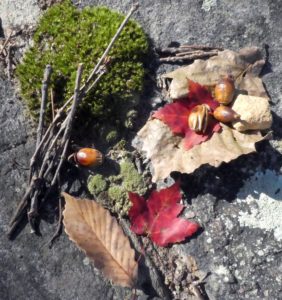
Lincoln asked us to give thanks “with one heart and one voice.” The Haudenosaunee ask us to give thanks with our minds as one. This Thanksgiving I am grateful that our president-elect is elevating competent, experienced people of diverse heritages into positions of leadership in a compassionate effort to heal our divisions and bring us back into a democratic union. Hopefully, this will extend, through climate change work, into healing our wounding separation from nature. I would ask that a true reconciliation be made with our Native brothers and sisters, as well.
Text (C) 2020 Betty Lou Chaika. Photos (C) 2020 Betty Lou and David Chaika, except photo Wild rice harvesting in Minnesota, from NMAI.
Notes
1. Mann, Charles C., “Native Intelligence”, Smithsonian Magazine, December 2005.
2. Mann, Charles C., “Native Intelligence”.
3. Deetz, Patricia, “What’s Wrong With this Picture? The True Story of the First Thanksgiving,” Muse, Vol 5 Number 9, November 2001, p.9 -14.
4. Lincoln’s Thanksgiving Proclamation
5. Deetz, Patricia, “What’s Wrong With this Picture? The True Story of the First Thanksgiving.”
6. Dow, Judy, “Deconstructing the Myths of ‘The First Thanksgiving.’”
7. American Indian Perspectives on Thanksgiving National Museum of the American Indian
8. This text is from widely publicized version of the Thanksgiving Address by John Stokes and Kanawahientun, 1993. The actual wording of the Address varies according to the speaker.
9. Kimmerer, Robin Wall, Braiding Sweetgrass, 2013, Minneapolis: Milkweed Editions.
10. Kimmerer, p.180.
11. Kimmerer, p.190.
In addition to the above sources, I am indebted for this information to the NMAI Harvest Study Guide, “Harvest Ceremony: Beyond the Thanksgiving Myth.”
Hart Pillow
Betty Lou and David,
Your narrative and photographs are beautiful and give us a real sense of the history of the Native
Americans who lived on this land originally.
Thank you so much!
May you be filled with joy and peace,
Hart Pillow
Betty Lou Chaika
Hart, so nice to connect with you again! I’m glad you found the story informative. Peace back to you and yours.
Neal
Nicely captured and written.
Betty Lou Chaika
Thanks, Neal.
Neal
https://madison.com/wsj/news/local/govt-and-politics/ho-chunk-nation-flag-to-fly-at-madison-municipal-building/article_0df9fa6a-bb29-57e7-92d6-bf0b57c9b56e.html
Betty Lou Chaika
Thanks for sending this. The Ho-Chunk flag is so much more meaningful and attractive!
Neal
The Ho-Chunk Nation flag will be flying at the Madison Municipal Building starting Wednesday, the city announced.
Mayor Satya Rhodes-Conway signed a proclamation on Wednesday stating that the flag would be flown “in honor of Ho-Chunk Day and in recognition of the fact that the City of Madison is located on the Nation’s ancestral land.”
In 2016, the City Council declared the day after Thanksgiving “Ho-Chunk Nation Day” in the city.
Betty Lou Chaika
Neal, This made me happy. I began to imagine every municipality flying the flag of the indigenous nation on whose land they live, alongside their own. Seems so right, and not just on one day, but every day.
sharon
thank you
Betty Lou Chaika
Sharon, you are so welcome. Thanks to you for your poems of gratitude, too!
Robin
Reading this started my thanksgiving morning with a poignant feeling of sacredness that I wish to carry through the day. In appreciation for your timely writing once again.
Betty Lou Chaika
Robin, knowing how attuned you are to ceremony, I would love to hear how you celebrated Thanksgiving in a sacred manner.
Barb Stenross
Thank you, Betty Lou. I felt this deep in my soul.
Betty Lou Chaika
Yes, Barb, with your deep connection to the natural world, I bet you did!
Saundra Kelley
As one who knows deep remorse for the deeds of my European ancestors, I appreciate the way you presented the experience of the First People. It is truth that is difficult to read but must be acknowledged. I am thankful for you.
Saundra Kelley
Betty Lou Chaika
Hi Saundra, thanks for your response. Yes, truth telling and owning responsibility must come before any hope of reconciliation. Facing our shame at what we have done to Native Americans is a first step, but I believe that includes embracing our own indigenous European cultures and seeking our ancestors’ help in making amends.
Margot Ringenburg
“The old Lakota was wise. He knew that man’s heart away from nature becomes hard; he knew that lack of respect for growing, living things soon led to lack of respect for humans too. So he kept his youth close to its softening influence.” — Chief Luther Standing Bear
Betty Lou Chaika
Thanks, Margot. Yes, I sure feel my own hardening of heart and then the welcome softening that accompanies reconnecting with nature. Bet you do, too.
Laurie Lindgren
Thank you so much for this beautiful tribute, teaching, and thankful acknowledgement of what we owe to our brothers and sisters and what we owe to them. May awareness be a beginning, but not the end. There is never too much reminding about our relationship with the land we walk on and the people who were here first and are still here, remembering, re-membering.
In love and gratitude,
I leave a pinch of tobacco for you.
Laurie
Betty Lou Chaika
Yes, Laurie, learning from Native Americans, and even appreciating them, is definitely not enough. Acknowledgement must be turned into action for equity, reparations, and reconciliation. May we walk on this sacred, this sanctified, ground together, with love.
ann loomis
Betty Lou, I’m so glad you mentioned the book “Braiding Sweetgrass,” as it’s on my Christmas list. I think all of us are looking for concrete actions we can take to reconcile with the sacred land. Having grown up on the land of the Lumbee natives, I felt a deep karmic response to your article. When we lose our connection to the land, we lose a piece of our soul. That’s how they must feel.
Betty Lou Chaika
Ann, Braiding Sweetgrass is one of my all time favorite books. I’m sure you will enjoy it. Of all the tribes at the NC Festival, I was most moved by the Lumbee women with their lovingly created, distinctive dresses. Yes, your roots and their roots are deep in the flow of the river. You are deeply connected to the land, and I look forward to your memoir about growing up there.
Jerry Reynolds
Betty Lou,
Thank you for such such an insightful discussion of “Thanksgiving”! Thanksgiving has been so sanitized and commercialized, that we have lost the true inspiration for the celebration and have hidden the settlers piracy of the land on which Native Americans had forged such an enduring and respectful coexistence with all of nature. I just hope that your message reaches more people and that we learn from this history.
— Your friend and lover of nature, Jerry
Betty Lou Chaika
Jerry, I know how interested you are in the American Indians who lived in harmony with this land we call North Carolina. I recall how moved you were to find arrowheads on your own land. I have been a grateful participant on fieldtrips in which you teach us about the presence of historical NC tribes. Thanks for your work, friend!
Barbara J
I especially resonated with the specificity of your Thanksgiving research, and with the photos of Native American Indigenous people. Thank you! And your words about the importance of connecting ourselves to all aspects of the amazing web of life that holds us – these are a powerful reminder of how to live each day. We forget…… so reading this brings us back to the ‘vibe’ to try to stay in and with.
Betty Lou Chaika
Yes, Barb, Native Americans, with their respect for the hoop, the circle of life, have so much to teach the rest of us. My questioning the legitimacy of the myth of the “First Thanksgiving” represents a tiny ‘calling out’ of of our ongoing failures to face our treatment of Native Americans, past and present. We continue to see how white supremacy oppresses all peoples of color. May we learn to express gratitude, daily, for that which holds us, as you so beautifully say.
Barbara J
A friend just sent an article from USA today, dated Nov. 25, which narrates some of the real history of Thanksgiving. I’m glad it is in that paper, though Betty Lou’s account is much more readable and in-depth. Hopefully, more folks will be sharing and talking about this so its reality begins to become the story that we tell about this holiday.
Betty Lou Chaika
I’m happy to hear that this mainstream paper is trying to tell the true history of Thanksgiving. Like you, Barb, I hope that the real story of what has been done to Native Americans will become better known. Thanks for your kind words about this piece. Feel free to pass it along if you see an opportunity to share it.